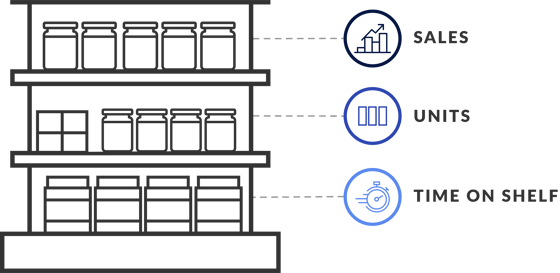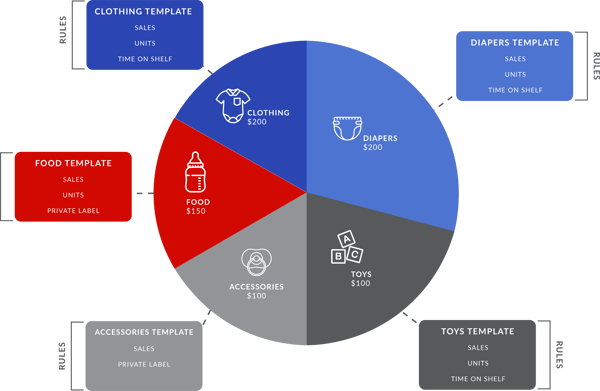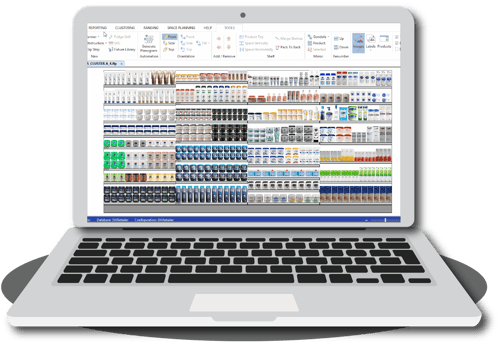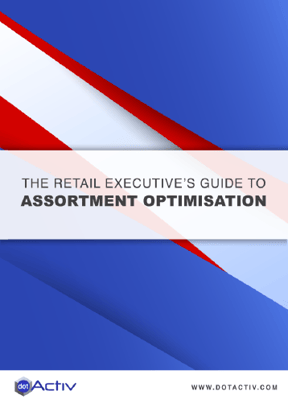
ASSORTMENT PLANNING
Assortment planning is the process of selecting the collection of products that will be on offer in particular areas (localisation) and during specific periods (seasonality).
It considers the financial objectives and seasonality of the product selection so that retailers and their customers gain from the outcome.
TABLE OF CONTENTS
WHAT IS ASSORTMENT PLANNING?
Assortment planning is the process of selecting the collection of products that will be on offer in particular areas (localisation) and during specified periods (seasonality). It considers the financial objectives and seasonality of the product selection so that both you and your customers gain from the outcome.
Assortment planning entails evaluating individual product attributes, including Brand, Size, Style, Colour, Function, Price and Stock Keeping Unit (SKU) performance during selection to address the preferences and needs of your customers. The assortment plan defines the products that make up your categories, sub-categories, segments, and sub-segments.
WHY IS ASSORTMENT PLANNING SO IMPORTANT?

Optimising shelf space and the product selection within that space has always been a primary concern for retailers. The reasons for that are because the assortment of products is critical to demand generation and shopper satisfaction.
One of the main ways retailers can increase their financial performance is by increasing customer satisfaction levels by offering various products.
A critical factor to consider during the assortment planning process is that assortment variety increases inventory costs. Therefore assortments need to be optimised.
From the supplier’s viewpoint, assortment selection and category space allocation are equally critical. Suppliers can’t generate any sales if their products are not on store shelves.
A COMPETITIVE ENVIRONMENT WITH NEW ARDENT EXPECTATIONS

As retail channels blur, assortment decisions are more vital than ever and determine whether or not a retailer can stay relevant in a competitive environment. There is a growing imperative for retailers to tailor their assortments by neighbourhood to respond to local preferences and offer shoppers the right products at the right place and at the right time.
It implies that product assortments are tailored store-by-store and category-by-category depending on your clustering strategy.
With that said, we see that modern category management is tasked with “assorting to the individual”. This customer-centric approach to category management puts your customer at the centre of all decisions made and focuses on which products to place on offer, how to group them, and how to display them.
In practical terms, this means identifying the customer segments present within your shopper base and setting up category strategies evolving around the four Ps, namely Product, Place (or merchandising), Price and Promotion. Doing this allows you to reach each segment.
ACTIONS TO CONSIDER FOR ASSORTMENT PLANNING
1. IDENTIFY CONSUMER DECISION TREES AND CUSTOMER SEGMENTS
Before selecting your product assortment, you must identify the different consumer decision trees present within a category. Simply put, a Consumer Decision Tree (CDT) is a graphical record of the thought process that any shopper goes through when selecting a product in a category.
This graphical record outlines the different product attributes that make up the purchasing decision. For example, a customer may look at price first, then flavour, then size and brand last.

That said, it's unlikely that there is only one consumer decision tree per category. There are different consumer behaviours based on cultural, personal, physiological and social factors that exist within a consumer base. For each of these segments, there is a different focus or priority.
For example, your customers may be price sensitive which means the price will be higher on their Consumer Decision Tree.
Using CDTs helps you understand not only the buying behaviour of your customers but also to grasp the expectations of each customer segment. You can translate this product knowledge into your assortments, which align to a retail strategy with consumer behaviour.
2. DEVELOP A STORE CLUSTERING STRATEGY
Store clustering or store grouping is the grouping of stores based on similar store and demographic characteristics. Store clustering is a critical step for the assortment planning process as it helps you create localised assortment plans that meet the needs of local shoppers.
Once you have determined your store clusters, you can create assortments for each group to meet the demand patterns specific to each store cluster.
There are essentially two ways you can cluster your stores.
PERFORMANCE-BASED STORE CLUSTERS
You would group these according to how they perform. For example, you would place store locations with similar sales performance in the same store group.
NON-PERFORMANCE BASED CLUSTERS
You would group these according to store characteristics such as demographics, store size or store type.
One productive way to identify store clusters is to measure the share of sales by store for each segment and compare the results across multiple stores (heat mapped floor plans are a useful tool to measure category performance and relative category space allocation). By doing so, you can see if there are similar trends among categories.
For example, an analysis of the Cereal category might reveal that in some stores, there is a significantly higher percentage of sales for the “Health” segment, while another group of stores shows a higher percentage of sales for the “Kids” segment.
This difference in sales could suggest that the first group is a health-oriented cluster, and the assortment for the Cereal category must pay particular attention to the health segment. Subsequently, additional research by analysing factors such as age, income, ethnicity, and so on will help you to identify similar neighbourhoods and validate the existence of a particular store cluster.
THE TWO PRIMARY SPACE AND ASSORTMENT VARIATIONS
The first thing to do when approaching clustering is to identify the two primary space and assortment variations that will drive localised assortments across your retail universe in almost every case.
1. SHOPPER DEMAND VARIATION AMONG CATEGORIES
The shopper demand for different products will vary from store to store depending on multiple factors, including Demographic, Location, and Seasonality. You can measure the factors by analysing internal point of sale data and external market data.
2. THE STORE FORMAT
Floor space in a particular store is a crucial element for creating a category assortment. Each assortment should take into account the space available across multiple stores.
CREATING LOCALISED ASSORTMENTS FOR EACH STORE CLUSTER
Store and category-based clustering are at the core of your assortment planning strategy. As stores across a retail universe may present a difference in demand among categories, you can group stores or categories that present similarities.
You can then generate localised assortments for each category or store cluster to meet the needs of local shoppers.
When creating localised assortments, there are two categories of products to identify:
BASE RANGE
Products in the base range will stay the same across all of your stores regardless of local preferences. The base range will usually comprise the most popular products and brands that your shoppers expect to find across all of your stores.
You can use assortment optimisation software tools to reveal brand and SKU strengths and help them select these products and brands.
CUSTOM ASSORTMENT
These are the products or segments specific to each store cluster. These products are tailored to the needs of each cluster and relate to the preferences of particular customer segments.
For example, if the customer segment in a particular cluster is price sensitive, you might want to place more economy products to retain the loyalty of this customer segment. If the customer segment is convenience-driven, you can offer products in a convenient and appealing format. That will optimise your chances of increasing sales.
3. ALIGN INTERNALLY AROUND CATEGORY ROLES
Before creating assortment plans, you must align internally around the role each category plays in your merchandising strategy. You must also understand the implications those roles will have on category space allocations and assortment decisions.
How does each category relate to one another in your store from a consumer point of view? Also, where does each category fit into the shopping experience?
By answering this question, you can adopt a more customer-centric approach to your category management strategy. The correct merchandising strategy will enhance the strengths of a category.

The four major consumer consumer-based category roles are:
- Destination;
- Routine;
- Seasonal; and
- Convenience.
It is vital to determine the role of each category beforehand as it determines and directs the merchandising strategy that will be put into place to deliver on the category role. Ultimately, it will affect product selection and space allocation.
For example, if you give your Meat category a Destination role, you will most likely focus on a merchandising strategy that will increase traffic and defending your market share. To do so, you need to allocate more space to this category, keep margins relatively low to be attractive, and offer an excellent selection and variety.
4. LOCATE CROSS-MERCHANDISING OPPORTUNITIES TO INCREASE SALES
Cross-merchandising is a tactic that category managers use to drive additional in-store sales. It is a Transaction Building strategy and focuses on increasing the size of the average basket. It achieves that by encouraging your consumers to purchase complementary products.
For example, instead of only buying a bag of crisps, a customer would add salsa sauce to their basket. Or, when purchasing paint, your customer would buy paintbrushes too.
Spotting the products which can be cross-merchandised before creating an assortment will ensure that you take full advantage of every opportunity to increase your sales.
5. LEARN THE THEORY OF TRANSFERABLE DEMAND
Knowledge of transferable demand metrics within a category has a significant impact on your assortment plan. It can help you prioritise a specific SKU or encourage the inclusion of an SKU in an assortment.
By analysing how products perform within a category using assortment planning software, you can compare SKUs and determine whether SKU volume is more or less likely to be transferred to another SKU remaining in the assortment. If you do not consider this challenge or opportunity during the assortment planning process, you can place the category at risk.
For example, which products are showing high levels of loyalty? You'd usually prioritise high loyalty SKUs in your assortment plan over lower loyalty SKUs because you can transfer low loyalty SKUs to other SKUs in the assortment.
Secondly, which products show high levels of exclusivity?
Highly exclusive products have less transferable demand and therefore should be kept or added into the assortment. Removing SKUs with high levels of exclusivity would put the category at risk and may drive your customers to shop elsewhere.
6. DEFINE AN ASSORTMENT PLANNING STRATEGY
Assortment planning is a critical step of category management. However, it is not independent of other category management decisions. Assortment plans should always consider your business strategy and the set of goals that you pre-define. That's because it will affect the space and the product selection attributed to each category.
Once the strategy has been agreed upon internally, it will give direction as to what merchandising tactics you should put in place to achieve your goals.
For instance, you might choose to target a specific customer segment such as a price-sensitive segment or a convenience-driven segment. Other elements to consider in your assortment planning strategy include the pricing strategy you adopt and whether you will focus on higher profit margin products or push for higher volumes or units of merchandise
Another element to consider is the Image Enhancing strategy that you will use to enhance your positioning in the marketplace. You will determine your overall image positioning based on any area of the assortment plan relating to quality, variety, price, service, presentation, delivery and brands available.
THE 4 PILLARS OF ASSORTMENT PLANNING

PEOPLE SKILLS
With the knowledge and skills required to develop optimised assortment plans, it can be time-consuming for you, especially without the right people skills.
You'll often find that outsourcing this function to third-party experts who have developed this skill over time is the most efficient solution for your business.
Your executives can focus on higher-level strategy and ensure that your brand strategy is communicated and reflected throughout your stores.
ASSORTMENT PLANNING SOFTWARE
Planning localised assortments is highly dependent on effective software because of the highly data-intensive nature of category management.
DotActiv’s assortment planning software works from an SQL data platform and integrates with shelf and floor planning software.
The tool enables users and planners to plan localised assortments based on the unique strategies of retailers.
DATA
Localised assortment plans are effective when based on the right data.
To create a data-driven assortment using assortment planning software, you will need to source, clean and consolidate the following data:
- Retailer’s POS data in its most granular form;
- Store cluster groups (stores grouped by format and other similarities);
- Store fixture information (gondola measurements and current planograms or realograms);
- External market data;
- Loyalty card data; and
- Product data.
ASSORTMENT OPTIMISATION
Assortment Optimisation is often perceived as too complex to implement. That's not true.
You can achieve it with the right tools, the right skills and the right process. It includes cleaning and consolidating your data, stapling down your merchandising principles, aligning your merchandising strategies with your assortment planning strategy, and using software to apply it.
WHAT’S THE END GOAL OF ASSORTMENT PLANNING?
With today’s competitive pressures, assortment optimisation is vital to customer satisfaction. Although you could view the decision to optimise assortments as hard to implement, the right combination of data, strategic decisions and enabling software will ensure that you offer the right mix of products to shoppers.
By combining internal and external market data with new predictive analytics software, you can explore multiple combinations and alternatives of category space and assortment plans, including assortment variations for each store cluster and format.
Adopting an assortment planning strategy will help you to retain the loyalty of your customers.
THE ASSORTMENT PLANNING METHODOLOGY

WHAT AN OPTIMISED ASSORTMENT LOOKS LIKE IN DOTACTIV ENTERPRISE
Baby Category, Cluster A
Last 3 Months
Behind every successful business undertaking, product or project is a methodology that acts as the foundation. In DotActiv’s assortment planning software, you can build assortments using Rules, Templates and Plans.
Rules are individual calculations used to rank products within a database and generate an assortment based on specific attributes.
These calculations relate to performance on non-performance based criteria such as Internal Market Sales Rank, Time on Shelf, Internal Market Units Rank, External Market Sales Rank, External Market Units Rank, House Brand, SKU size, Price, Brand, Colour, Flavour, and Profit.
Usually, you would apply two or three rules to each segment of a category. Once you have generated the correct assortment for each segment, you can group the products into templates and plans.
LET DOTACTIV HELP YOU BRING YOUR CATEGORY PLANS TO LIFE
Increase your revenue by between 5% and 30% by giving your products data-driven space allocations and applying consistent merchandising principles across your stores.
With our assortment optimization service, you'll get quick access to the expertise, software and process required to ensure you develop space and inventory-aware assortments, tailored to local shopper preferences.




